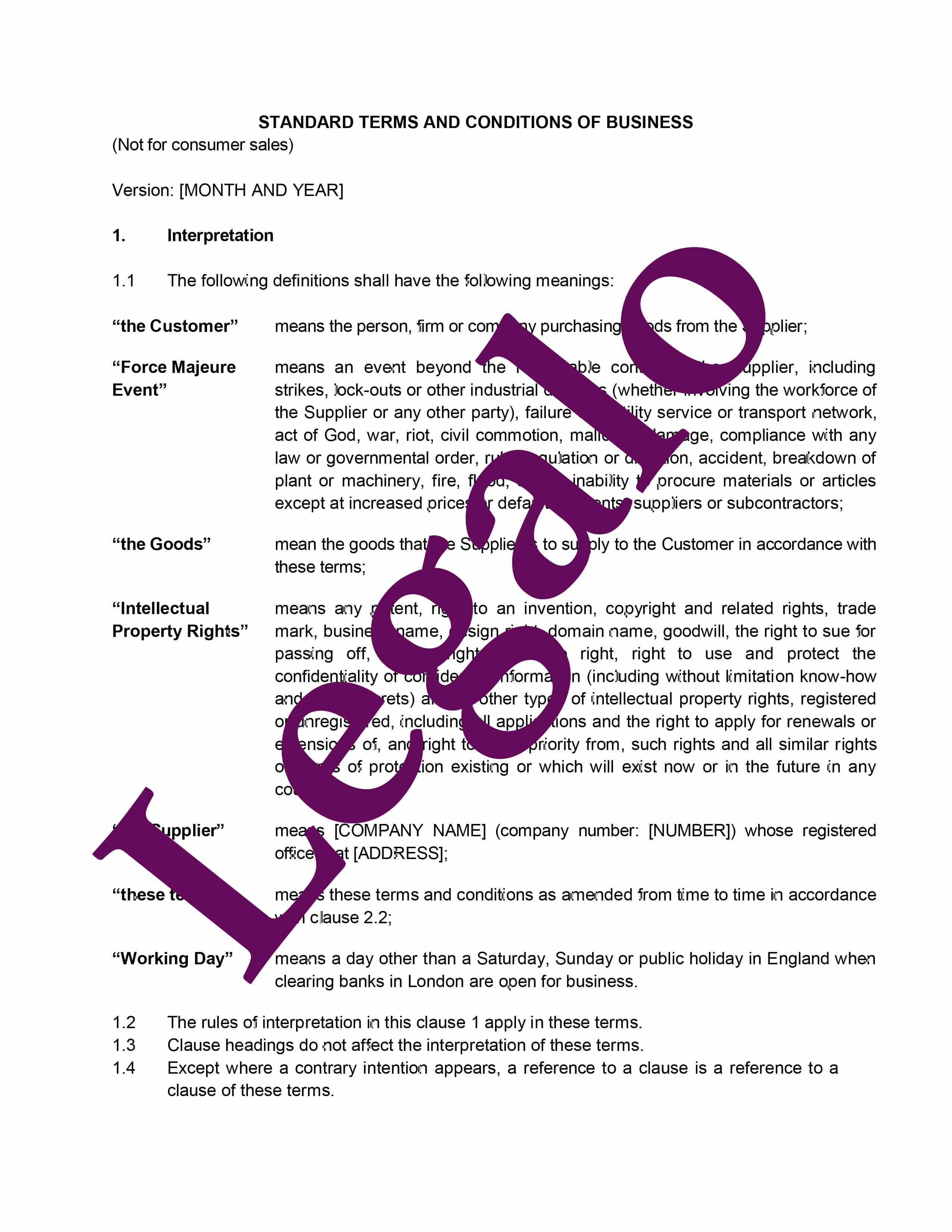Terms and Conditions of Sale – B2B – Goods Only
Our terms and conditions:
- money-back guarantee
- drafted by an expert UK lawyer
- for sales to other businesses – not consumers
- cost-effective legal peace of mind

How Does It Work?
-
1. Download
-
2. Edit
-
3. Print
-
4. Sign
MD, Legalo Ltd; Solicitor; Notary Public
Our Terms and Conditions of Sale template is for use if you sell goods to other businesses (not to consumers), but do not supply services as well (e.g. installation of the goods), other than delivery and related insurance.
These terms and conditions of sale can be used whether:
1. you sell via a retail or trade outlet; or
2. you sell via your website.
If you sell goods and services or just services, then see our other Terms and Conditions of Sale template for B2B sales of goods and services. Where you sell to “consumers“, see our:
- Website Terms and Conditions templates for sales of goods to consumers; or
- Terms and Conditions of sale of goods and services to consumers.
If you sell via the Internet, then, in addition to these terms that govern the contract for the sale of goods, you may also need our templates for:
Consumer protection & terms and conditions of sale
When selling only to other businesses, you can have more robust or harsh terms and conditions of sale than you if you were dealing with consumers, due to the extensive consumer protection rules that apply to protect consumers. This version of our various templates for terms and conditions of sale is only suitable for sales to other businesses.
Distance selling
There are no special terms that apply to sales from one business to another business if it is done online or via telephone (distance sales). This is in marked contrast to when you sell to a consumer.
Using these terms and conditions of sale
To use these terms effectively, you must ensure that a copy of your terms is sent to the customer in each case or seen by them (or agreed to by them) on your website before the sale contract is agreed or concluded. For example, you can put them on the back of your quotation forms (which are sent before the contract is concluded), but you should not send them out on the back of your invoices, as that will be issued after the contract has been concluded – it is therefore too late to send the terms at that stage.
For repeat orders, so long as you have sent your terms once to the customer or they agreed to them in the past via your website, then you do not have to re-send them every time the customer places an order. If you do not make the customer aware of your terms, then they do not form the basis of the contract and are irrelevant. Under English law, the customer does not need to read the terms in order to be bound by them.
If you update the terms, then you need to get the new version to your existing customers in some way – by post, by email or by their agreeing to the terms again when they place their next repeat order via your website. If you do not do this, the contract will still be on the basis of the old terms for your existing customers.
Do terms and conditions of sale need to be signed?
For important contracts (e.g. large orders), it can be useful either (a) to get your customers to sign the terms and conditions of sale or (b) to send you a letter or email that specifically refers to their accepting that your terms are agreed to as the basis of the contract or order. You should then keep a copy on file. For normal run-of-the-mill orders, it is not generally thought necessary to have the terms signed by each customer and held on file, but you must be able to prove they were given the terms before the contract was concluded.
The “battle of the forms”
If your customer has their own terms of purchase (e.g. on their purchase order) and insists their terms are the basis of the contract, then you have a battle over which set of terms applies. Lawyers call this the battle of the forms. The rules are that the last set to have been sent before the contract is concluded will be the terms that apply to the contract. In basic contract law terms, you have formed a contract when there is an offer and an acceptance of it.
Printing these terms and conditions of sale
If you are planning on printing these terms on the back of your quotation forms, once you have finalised the draft, then reduce the margins, paragraph spacing and font size to suit your needs and try putting them into 2 columns. You should be able to get them onto one A4 page with some extreme adjustments (you may need a font size of about “5”).
What follows is an excerpt on the key terms in this template from the guide to creating your terms and conditions from this template – a full guide accompanies the template when you buy it.
Clauses in these Terms and Conditions of Sale
1. Interpretation
This clause defines the main terms used in the terms and conditions of sale.
- Customer – the business you are selling to (there is no need to insert the specific details of any particular customer here).
- Force Majeure Event – this is a list of events outside of your control that may give you an excuse for delay or termination of the contract – see clause 12 for further details.
- Goods – this is a generic reference to the goods you are selling.
- Intellectual Property Rights – this definition lists the different types of intellectual property rights, which are relevant to clause 15.
- Supplier – fill in the details of your business/company here.
- these terms – this means the terms and conditions.
- Working Day – this defines a working day for the purposes of the notice provisions and other periods in the terms.
2. Basis of the sale
Although clause 2.1 attempts to exclude any terms proffered by a customer on their purchase order, this clause may not be effective – see the above rule about the last set of terms before the contract is formed being the ones that apply. Clause 2.3 puts a limit on the validity of any quotation that is not taken up quickly. If you send out an acknowledgement of order for all orders that you accept, then keep clause 2.4. If not, delete it.
3. The Goods
Clauses 3.1, 3.2 and 3.3 state you are not selling exact matches to the pictures or samples on your website or in your catalogue. This permits you, the seller, some flexibility. However, don’t abuse this by significant changes to the goods from the pictures, etc. You will only need clause 3.4 if you sell goods in bulk (e.g. bulk sales of grain and fresh produce) and the quantity might very by a few percentages above of below the exact amount ordered – this permits a slight variation in the amount actually delivered. Adjust the permitted percentage variance if you wish. Delete clause 3.4 if you do not sell in bulk.
4. Price
In clause 4.1 select whether the price is as per your website, quotation or acknowledgement of order. Clause 4.2 states that delivery charges, etc may be in addition to the quoted price. Despite clause 4.1, clause 4.4 allows you a little flexibility on price, but if the price change is over 5%, the customer has the right to cancel the order (unless you delete this last sentence). Again, adjust the permitted percentage variance if you wish.
5. Cancellation
If you delete the right of cancellation in the last sentence of clause 4.4, then delete the initial phrase in square brackets from clause 5.1 and start the remaining sentence with a capital T on “the”. This clause makes it clear the customer cannot simply cancel its order once made.
6. Payment
Clause 6.1 in the terms and conditions of sale requires payment to the supplier’s nominated bank account. Fill in the number of days the customer has to pay in. For example, 30 days from the date of the invoice. In clause 6.3 there is provision for charging interest on late payment. NB the monthly percentage currently specified in this clause is not the same rate as applies under the Late Payment of Commercial Debts (Interest) Act 1998 of 8% over the Bank of England base rate – you can choose your own contractual rate rather than rely on the Act and 2% per month is higher than the current annual rate you would get from the Act. Fill in the percentage interest you might charge.
Clause 6.4 states that if you allow the customer to pay by instalments, any default in paying those on time will mean the whole of the balance is immediately due. If you do not permit instalment payments, then delete the whole of clause 6.4 and the words in square brackets in clause 6.5. Clause 6.5 states that if the customer is in financial difficulties (see the list in clause 13.1), then all payments become payable immediately.
7. Delivery
Clause 7.1 in the terms and conditions of sale permits delivery by instalments (if relevant). Clause 7.2 permits the supplier to charge extras if the customer causes difficulties for the delivery of the goods or refuses delivery of goods that are correct. Delete the second sentence of clause 7.2 if the customer does not need to assist in unloading to goods. In the third sentence of clause 7.2, choose the first option if the supplier delivers the goods and the second option if the customer is to collect them or arrange collection of them. Delete whichever option does not apply.
If choosing the second option, fill in the number of days after which delivery is deemed to have taken place. From this point:
- the risk in the goods passes to the customer, and
- the duty to insure the goods is on the customer, whether the customer has actually collected the goods or not.
Clause 7.3 governs the return of packaging material, e.g. pallets and materials the supplier needs to take back for recycling. Clause 7.4 gives the supplier some flexibility on delivery dates quoted. If the customer is to collect the goods, keep clause 7.5 and complete the details; otherwise delete it.
8. Retention of title
This clause, about retention of title to the goods until they have been paid for, gives the supplier a self-help right to reclaim the goods if they have not been paid for and if the supplier can do so peaceably (i.e. without force) – see clause 8.3. It still does not permit “breaking and entering” on the customer’s premises to do so. That would be a criminal action. If there are no other companies in the supplier’s group then delete the words in square brackets in clause 8.1.
9. Warranties (sale of goods)
This clause in the terms and conditions of sale sets out the warranty given by the supplier. Complete the details of the warranty you are giving in clause 9.1. Complete the warranty claim deadline in clause 9.1.1. Clause 9.3 reminds the parties that this is a business to business sale and not one to a consumer. As stated above, these terms are not suitable for sales to consumers. This is because they do not reflect the consumer protection legislation.
10. Limitation of Liability and Customer’s obligations
This clause seeks to limit or exclude the supplier’s liability in case something has gone wrong. However this is still subject to the warranty under clause 9. Delete clause 10.2 if the customer will never supply any property to the supplier. This might cover tooling from which the goods are to be made for example.
11. Indemnity from the Customer
This clause in the terms and conditions of sale includes a basic indemnity from the customer for damage. It covers damage suffered by third parties (e.g. the customer’s customers), unless caused by the negligence of the supplier.
12. Force Majeure
Clause 12.1 relieves the supplier from liability for delay caused by events outside of its control. Clause 12.2 allows the supplier (but not the customer) the right to cancel the contract if this event prevents delivery for a number of weeks (fill in the number). You can modify this to permit the customer also to have a right to cancel under these circumstances.
13. Default
In the event of the customer’s breaching the contract and not remedying that breach or becoming insolvent, etc, the supplier can terminate the contract under clause 13.1. Clause 13.3 allows the supplier to suspend future deliveries by instalment if the customer is behind on payments. Clause 13.4 states that on termination all sums payable become due immediately.
14. Arbitration
Clause 14.1 of the terms and conditions of sale states that, rather than going to court, you will refer disputes to arbitration.
15. Intellectual Property Rights
Clause 15.2 gives the supplier an indemnity. This is in case the way the customer has specified the design for the goods breaches another person’s rights.



